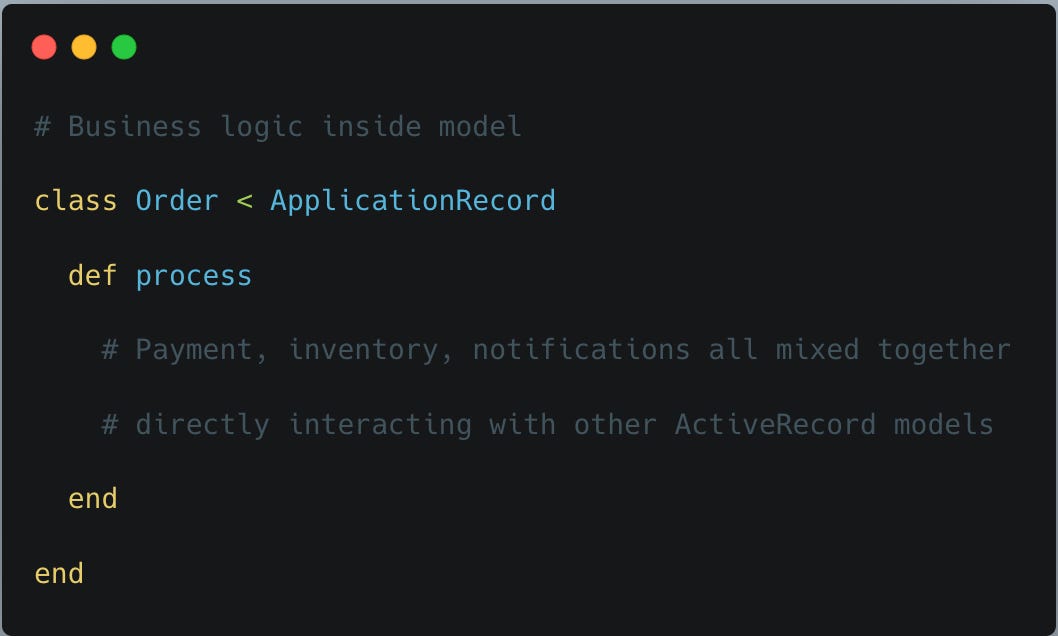Two months ago I was working with a client their codebase had become a tangled web of responsibilities. Models were bloated, controllers were handling business logic, and debugging had become a nightmare. You know that moment when you spend more time figuring out where code should live than actually writing it? … yeap.
In this issue, I'll take you through our journey to implement proper Service Objects in our Rails application. No theory dumps – just real code, real problems, and real solutions.
🚀 What you'll learn:
Why Service Objects should be isolated from ActiveRecord and Controllers
How to properly structure business logic with Use Case Objects
Avoiding common pitfalls like "Shotgun Surgery"
Creating a maintainable directory structure for your Rails app
The Problem
Our Rails app had grown organically over two years, and our "architecture" had devolved into dumping everything into models or—worse—controllers. Finding where business logic lived had become a treasure hunt.
Here's what we were dealing with:
💡 Warning Signs:
Models doing way too much (violating Single Responsibility)
Business logic tightly coupled to ActiveRecord
Testing was a nightmare requiring database setup
Changes in one area required updates in multiple places (Shotgun Surgery)
No clear boundaries between persistence and business logic
The Journey: From Problem to Solution
Step 1: Separating Service Objects from ActiveRecord
Before:
After:
🎯 Impact:
Clear separation between persistence and business logic
Service is focused on orchestrating the order process
Easier to test business logic in isolation
Changes to business rules don't require modifying the ActiveRecord model
Step 2: Adopting Use Case naming and proper directory structure
We renamed our service objects to better reflect their purpose and organized them into a clear directory structure.
Before:
After:
With our top-level namespace:
The Aha Moment
The breakthrough came when we realized service objects should be completely independent and callable from anywhere. They represent specific business actions, not extensions of models or controllers.
Real Numbers From This Experience
Before: 75% of our business logic was in models, 15% in controllers, 10% in helpers
After: 85% in properly structured use case objects, 15% in models (only persistence concerns)
Test suite runtime: 30% faster without needing full ActiveRecord setup
New developer onboarding time: reduced from 2 weeks to 5 days
The Final Result
🎉 Key Improvements:
Clear separation of concerns between controllers, models, and business logic
Explicit inputs and outputs for business operations
Better error handling with descriptive messages
Transaction handling in the appropriate place
Easily testable business logic in isolation
Monday Morning Action Items
1. Quick Wins (5-Minute Changes)
Identify one bloated model method that can be extracted to a service object
Create a dedicated directory structure for your business logic
Start using explicit Result objects instead of boolean returns
2. Next Steps
Audit your codebase for business logic hiding in controllers
Create use case objects for core business operations
sUpdate your team's style guide to include service object conventions
Your Turn!
The Service Object Challenge
Look at this controller action. How would you refactor it using proper service objects?
💬 Discussion Prompts:
What should be the responsibility of the controller vs. service object?
How would you handle errors from the Stripe API?
Where should transaction boundaries be placed?
🔧 Useful Resources:
Found this useful? Share it with a fellow developer! And don't forget to let me know what architecture challenges you're facing in your Rails apps.
Happy coding!
Pro Tip: Create a template for new service objects to maintain consistency
Remember: Service objects should be callable from anywhere - controllers, jobs, rake tasks, or even other service objects










